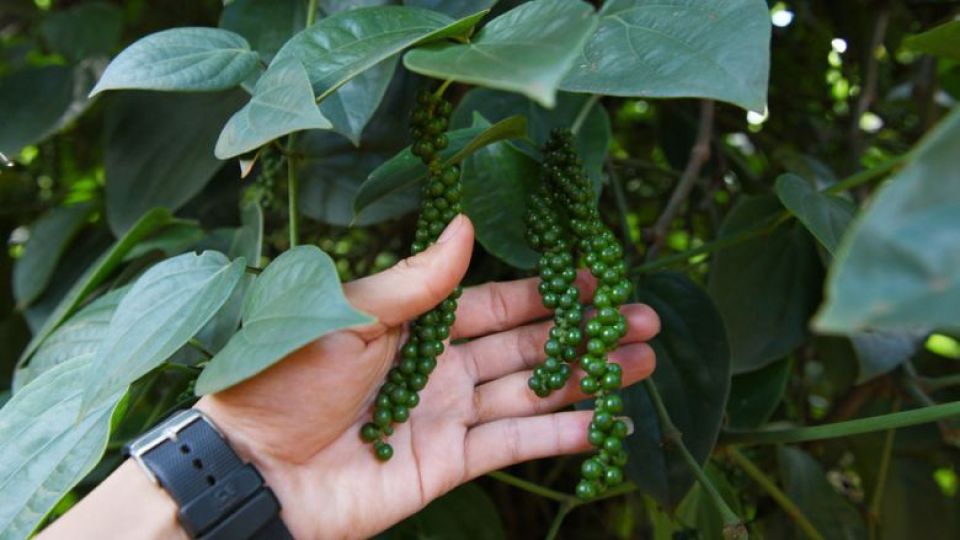August 26, 2022
Cambodian – peppercorn exports in the first seven months of 2022 were 69.04 per cent lower on a yearly basis, in a drop insiders say was a result of demand slump triggered by Covid hangover and uncertain economic recovery, compounded by the ongoing Ukraine conflict, but is no cause for concern.
The Ministry of Agriculture, Forestry and Fisheries reported that this year’s peppercorn exports stood at 6,990.7 tonnes as of July 31 – down from a respectable 22.58 kilotonnes in January-July 2021 – with Vietnam buying the lion’s share at 6,298.89 tonnes or 90.10 per cent.
Other top destination markets for the period were Germany (608.44 tonnes), Taiwan (21 tonnes), France (15.08 tonnes), Malaysia (13.64 tonnes), Belgium (13.24 tonnes), the Czech Republic (8.18 tonnes), Japan (2.94 tonnes), Sweden (2.78 tonnes) and Canada (1.28 tonnes), with the US, India, UK, South Korea, Lithuania, Switzerland, Kazakhstan and Australia each buying less than one tonne.
Cambodian Pepper and Spices Federation (CPSF) president Mak Ny told The Post on August 23 that the industry is coping with a downtrend in global demand for peppercorn, which he credited to the prolonged spread of Covid-19, Russia’s military offensive in Ukraine and the uncertainty around economic growth.
He explained that peppercorn exports were also held back by a 10 per cent year-on-year dip in prices for the commodity that has made farmers hesitant to sell to traders, as well as an insufficient supply of sunlight to dry the berries, in a year marked by unusually high rainfall.
And Vietnam remains the biggest buyer of Cambodian peppercorn largely due to a lack of warehousing and drying facilities in the Kingdom, along with the prohibitively expensive costs associated with exporting the spice to more distant markets, he said, sharing that a CPSF working group is looking into shipping pepper to Middle Eastern countries as well.
He remarked that the current prices for dried black pepper bought directly from farmers is around 12,000-13,000 riel ($3.00-3.25) per kilogramme, down from 14,000-15,000 last year.
These going-rates are rather economical, especially when compared with the prices for the most highly-prized variety, Kampot pepper, which is grown in the coastal province of the same name and is the sole cultivar protected under national geographical indication (GI).
The per-kilogramme prices for this type of peppercorn have remained the same for several years, at $15 for black, $25 for red and $28 for white, Kampot Pepper Promotion Association president Nguon Lay confirmed to The Post.
Lay revealed that the export figures for Kampot pepper have also been lower so far this year, explaining that the harvest was only completed in early August, due to excess rainfall, and that more time is needed to dry the fruits for overseas shipping.
Nonetheless, he emphasised that the GI tag would ensure that full-year exports are similar to 2021 levels, adding that orders have been placed for the bulk of the peppercorn.
“Exports will be able to recover soon,” he stated.
Kampot pepper is grown on about 210ha, which can yield around 120 tonnes in a typical year, Lay said, conceding that heavy rains may have “slightly reduced” the quantity and quality of the 2022 crop compared to last year.
For reference, the agriculture ministry reported that Cambodia last year exported 28,074.79 tonnes of peppercorn, rising by 452.72 per cent from the 5,079 tonnes logged in 2020.
According to the CPSF’s Ny, the total area under pepper cultivation is estimated at roughly 6,000ha nationwide, with significant quantities grown in Tbong Khmum, Mondulkiri, Ratanakkiri and 15 other provinces, out of a total of 24.


